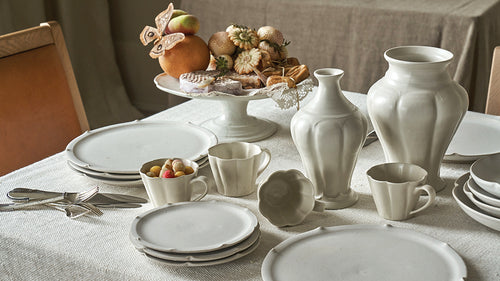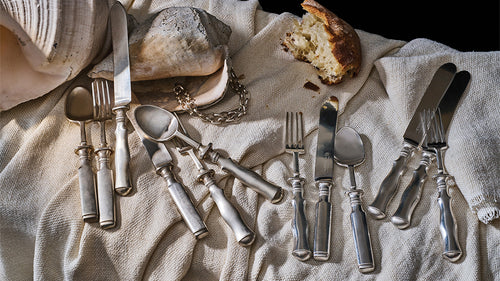THE EYE - - 9:46 AM
Indigo: Blue by Nature
We are excited to introduce our Modern Craft Series, a collection of posts on The Eye that will explore craft in the modern age. Our first piece focuses on Indigo, its storied history, and the beautiful objects and linens we have in store to share with you.
A color reserved for highest ritual, and celebrated too for its daily, practical use. Indigo is one of mankind’s most ancient and universal sources of blue dye, and right from nature herself. Why do we always find ourselves drawn to indigo?
Indigo takes its name from the plant most commonly used to extract the dye – indigofera tinctoria. This is not the only plant used to extract indigo, and not the only name used to refer to it. Ai in Japan, nila in India, gara throughout Africa, and anil in Central America - the story of indigo is a global one. A story of trade patterns, of vernacular traditions, and of global intersection and connection.
Artifacts dyed with indigo, from Peru, date to around 6,000 years ago, long before the Egyptians. With the late 15th century’s opening of trade routes, the engine of empire propelled the proliferation of indigo as an agent of beauty; vibrant blue-dyed cloth, clothing, and all manner of both practical and elevated textiles spread.
Despite the 20th century rise of synthetic dyes, older and authentic ways of dyeing with vegetal & vibrant indigo live on – living fast, dyeing hard. The steps to harvest and dye with indigo have as many variants as shades of blue it creates – but largely the process of steeping the plant’s green leaves, often in vats, until what was previously green is transformed into oceanic blue stays true. Textiles are immersed and emerge blue with richness and variety. Decorative patterns and motifs reflect the hand of the maker and remain a rite amongst this craft.
An excerpt on one part of this lively process, from a late 18th century treatise on the manufacture of indigo:
When the vat is prepared, fill it, as conveniently as you can with clear river or other water, to within six inches of the border. The Indigo should then be covered about four inches, shortly after you have poured in the water, there will rife with a kind of gush, from the bottom of the vat, large air bubbles, and a liquor, which breaking or falling, form as many circles, and spreads a light green tinge over the surface, and these by degrees change, and the water becomes of a very bright green. When the green colour has acquired its highest degree, the surface becomes covered with a beautiful coppery hue, and this in its turn by a scum of a very deep violet colour, although, the mass of the water remains always green…
This scum is so spirituous, that if you apply fire to one, it rapidly communicates to every successive body that rises, and the indigo during the fermentation, sometimes make such violent efforts...
We always want to know what’s in a word, as we love things that bear meaning. The long history of indigo exists today within words we might think of as particularly contemporary: “denim” and “jeans”.
Dating back to the 16th century, referring to the same durable indigo-dyed twill we all know and love, de Nîmes originally designated textiles produced in Nimes, France, and likewise Gênes (the French spelling, of course) meant those from Genoa, Italy.
Our indigo products are global in scope too – our own RW Guild Founding Collection linens are sourced from workshops across India.
Our Tensira pillows are made by husband and wife team Hamidou Diallo and Tuulia Makinen – combining a Nordic approach to this Guinean way of making & dyeing, all by way of Paris. Exclusively in-store, the vintage indigo textiles we offer come mainly from Japan. And we can’t wait to discover what we’ll find on our next travels.
Indigo – modern craft deeply connected to the natural and the imperfect, to local traditions of making, and ages of global cultural exchange. And used to beautifully color textiles and objects you can use in your home today. Ingenious, if you ask us.
-by Whitley Esteban
To steep a little longer in this indigo bath, we suggest the following resources:














